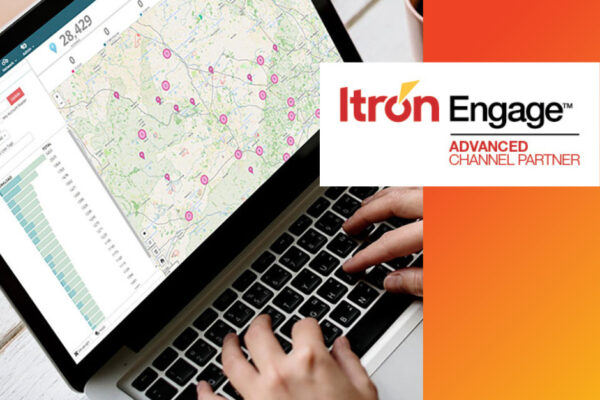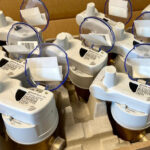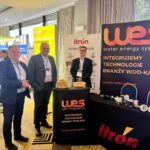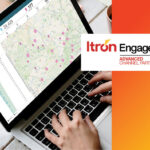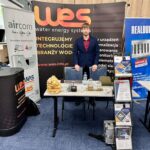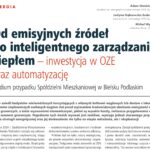From the moment we encountered the Covid epidemic, the issue of stationary reading of water meters has become more and more popular in the water and sewage industry. It is a popular, fashionable and necessary topic. However, it is also a difficult topic.
So our goal is to make it easier to understand it and the differences between mobile and stationary reading and the benefits of using each of them.
Mobile reading – a faster way to invoice every month
Drive by and walk by solutions are available for mobile reading. We had the pleasure to implement and test reading solutions from several different companies and our experience shows that in many places in Poland, water meters can be read from a moving car. However, in large city centers, where we have communication problems, water utilities send employees to take readings on foot after reaching a specific location.
Itron currently offers two systems: in the 433 MHz band, providing better transmittance and signal strength, but giving a slightly slower reading, and in the 868 MHz band – Cyble 5 modules, giving the possibility of a smooth transition from mobile readings to a stationary LoRa WAN system.
 Scheme of mobile reading of water meters
Scheme of mobile reading of water meters
We tried to summarize this kind of reading:
Strengths
- Quick employee training – less than an hour is usually enough to send an employee to the field,
- Quick software implementation,
- A large selection of reading tools – Tablet / Smartphone – our experience shows that customers are increasingly switching from tablets to smartphones, which now have very durable batteries and shock and damage resistant cases,
- Possibility of control / intervention reading – when there is a reading inconsistency, the employee is sent to the reading point to check the problem,
- Low system implementation costs.
Weaknesses
- Employee engagement for readings – labor costs,
- Involvement of company vehicles – additional monthly costs,
- Constant monitoring and verification of reading routes – as we know, routes require constant monitoring, water meters “live”, are replaced every 5 years, occasionally fail, similarly to radio modules, also the water distribution network changes daily,
- Data used for invoicing based on reading data,
- Possibility of balancing the water sold monthly, collection of data from the turn of the month.
When analyzing the real costs of the system, the following factors should be taken into account
- Employee’s salary
– PLN 2 500.00 net per month is the cost of the employer PLN 4 122.71,
– in the period of two legalization periods, with an increase in wages, it gives about PLN 628 301.00, - On foot or by car?
– 10 years of car maintenance – approx. PLN 426,722.00, - Devices for taking readings
– in a 10-year period, they should be replaced even about 3 times, - Software license or subscription.
Our practice shows that when comparing the costs of systems, water companies take into account only the costs of devices and licenses, forgetting about personnel and operating costs, which constitute a very high percentage of the total calculation.
To sum up, by using mobile reading, the company gains
- Reading the water meter without entering the building / apartment (employee safety against COVID),
- Significant acceleration of readings – for comparison, 40 – 60 water meters are read manually / day, mobile (radio) 800 – 1000 / day (450 pieces per hour in the Temetra system),
- Water meter status as at the reading date and at the end of the month,
- Readout of alarms detected by the radio module,
- Balancing of water sold on a monthly basis.
Stationary reading – Accurate daily data for billing, water meter selection, leak diagnosis and zone balancing.
The latest Itron system based on the Cyble 5 module operates in the 868 MHz band. enables a smooth transition from mobile to stationary reading based on LoRa WAN.
 Scheme of stationary reading of water meters
Scheme of stationary reading of water meters
As seen above, the stationary system eliminates the costs of personnel and vehicles. LoRa concentrators, managed by the water company or operator, are installed in the reading area. Simultaneously, in cities adopting Smart City technologies, LoRa masts are being installed in the urban infrastructure, which can also be used for water meter readings. However, this system retains the maintenance crews that analyze daily alarm information.
Using the same approach, here’s a quick summary of the key advantages, disadvantages, and benefits:
Strengths:
- Minimum number of field personnel,
- Full, daily control of modules and water meters,
- Advanced monitoring software,
- Reduced costs for equipment and vehicles,
- Data enabling water network diagnostics.
Weaknesses:
- Preparing the meter reading infrastructure,
- Infrastructure commissioning, maintenance, and servicing.
The actual system costs include:
- Hardware and software for module installation and configuration,
- Concentrator
Purchase and delivery,
Installation and configuration,
Location – energy and rent,
Maintenance and servicing,
Communication – SIM + transmission + security, - Servers
Hardware and software,
Administration and supervision, - Integration of the meter reading system with billing, SCADA, and monitoring.
More broadly, infrastructure is the main barrier preventing water utilities from using this form of data acquisition. Companies are reluctant to assume the role of operator and build data acquisition infrastructure. We observed the best LoRa implementations in locations where the utility, through connections with municipalities or public institutions, had guaranteed space and permission to place a small antenna on the roof. As a result, the water utility’s premises could be well covered with concentrators, without high costs or time-consuming negotiations with the owners of the tallest buildings in the area.
Maintenance and service are inexpensive, and outages are rare, although they are more frequent during autumn and spring storms, when rooftop antennas can be damaged. Service technicians don’t have to be water utility employees, and this is worth factoring into the calculation.
Regarding the cost of communication between concentrators and the central system, it’s important to remember that each concentrator contains a SIM card. The transmission itself isn’t expensive, but the costs of security, routers, encryption, and IT configuration come into play.
Recently, water utilities, using EU funds, have installed professional server rooms, racks, and servers. However, it’s worth remembering that if their parameters are adapted to mobile readings, they may prove insufficient. Water meters in a mobile system are read once a month, so 10,000 water meters per month yield 10,000 readings. However, if stationary readings are taken daily and data latching is performed hourly, we get 24 readings from a single meter 30 times a month. With 10,000 water meters, the amount of data and the server load increases dramatically. Calculations must then be made to determine whether the company’s current servers can handle this amount of data and whether the company has a dedicated person capable of analyzing such data.
Technical supervision is usually a difficult challenge, and companies outsource it to external experts. In terms of system integration, there’s no need to transfer 24 readings from 30 days per month to billing. Instead, one reading per month should be exported for invoicing, as before. The remaining data will be needed in other broadly defined monitoring systems. For example, departments that use flow meters and measure delivered water will be able to efficiently compare water sold with water produced on a given day. If our network is divided into zones, we can also assign water meters to these zones and obtain the actual water balance in the zones with hourly resolution! A stationary system significantly speeds up water network diagnostics.
By using stationary water meter reading, companies benefit from:
- Water meter reading without entering the building/apartment (employee safety during COVID),
- Data for diagnostics and water meter selection,
- Quick notification of alarms and irregularities,
- Daily water meter reading – billing at any time,
- Configuration of the radio module from the central system,
- Balancing of water sold on a daily or hourly basis.
As we can see, each system has its advantages and disadvantages. Each has its own costs. So which one should you choose?
What if you didn’t have to choose between one and the other? Perhaps a hybrid solution?
Hybrid – what does it mean?
This popular term today refers to things and concepts composed of various elements. Hybridity is synonymous with combining, compiling, crossing, and achieving better results based on multiple technologies. What kind of hybridity is it in remote reading systems?
Itron currently operates two solutions – a system based on 433 MHz transmission and a system operating in the 868 MHz band using two technologies. In the unidirectional system, the radio module often transmits at lower power, and the so-called transmit frame contains only basic parameters – the water meter status, possibly a latch, and alarms. Itron utilized the 433 MHz band and bidirectional communication. The radio module is in sleep mode, which translates into low power consumption. When it wakes up (when it receives a query from the RF Master), it sends a data packet for approximately 15 seconds (typically once a month), after which it goes back to sleep mode.
The solution that appears with the new Cyble 5 module combines the advantages of two-way communication with the popular 868 MHz band and fast mobile and stationary reading.

Cyble 5 module
The Cyble 5 module enables fast drive-by and walk-by reading in the 868 band, but can also operate as an IoT device. It can be configured for bidirectional mobile AMR (downloading significantly more data) or unidirectional (short status frame). The module can also operate simultaneously in a stationary LoRa WAN network. If problems arise with the concentrator, you can arrive on-site and read it mobile.
Using the latest RF Master and wireless M-Bus reading devices enables fast reading in both the Temetra system and the simple, open OMS standard.
Evolution instead of revolution – will hybridity help avoid radical changes?
Yes, because a water company can slowly and gradually install Cyble 5 modules without building a LoRa WAN reading infrastructure. They will read them using a fast drive-by system, and at the same time, they can begin using the city’s LoRa WAN infrastructure or build their own and connect the same modules to the stationary reading network. This allows the company to gradually, gradually, and without excessive start-up costs, transition from a mobile to a stationary system, and begin to benefit from the benefits of a stationary system without incurring the highest associated costs.

Zastosowanie Cyble 5 w hybrydowej formie odczytu
Cyble 5 is the result of the ongoing natural evolution of Itron modules, thus gaining more features than previous devices – it features fast readout capabilities, an extensive dataset, flow distribution analysis for 9 intervals, and an additional logger with 15-minute intervals, an additional 480 registers, advanced security, universal protocols, wMbus, and LoRa WAN, enabling integration with solutions from various manufacturers.
The optimal solution is to use the Cyble 5 module with the Temetra system. This cloud-based software is SaaS (software as a service).

Temetra system operation diagram
Temetra provides a comprehensive data collection infrastructure, allowing you to focus on leveraging the data available from advanced meters, not the technology used to collect it. It combines mobile and fixed network data collection from a wide range of technologies into a single, high-performance repository.
Because it’s a web-based service, businesses don’t need to purchase a dedicated computer or install any software. The system uses a highly reliable data storage and backup center. Data is always available for download to your computer as an XML or CSV file. Accessing the system via the internet doesn’t require additional work for your company’s IT department. Any computer or device with internet access can be used to log in and view meter readings and reports. There’s no need for internal networks or costly data transfers.
Businesses interested in a free trial of the Temetra system are welcome to contact us.
We are a certified Itron distributor.


Archival material – Jerzy Rogowski was part of our team from 2020 to 2024. He is no longer professionally associated with WES Sp. z o.o., but we are proud to present our joint projects from that period.

 European Union
European Union

